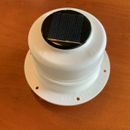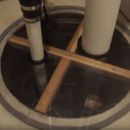Solar exhaust passive radon system – bad idea?
I’m in Buffalo, NY and my average radon level for the year is only 3.1 according to the Airthings Wave detector I have mounted to my cellar ceiling joist. However, that is with a completely open 18″ sump. So my idea was to make a clear sealed cover and vent a 3″ PVC pipe to the outside. I have also found neat solar fan exhaust that would fit perfectly onto the 3″ pipe. But of course would only run when there is direct sun or ambient light. Is there any danger in doing this?
(Photos attached)
GBA Detail Library
A collection of one thousand construction details organized by climate and house part











Replies
Not all fans are the same. The fan in the picture looks like is has less than a watt of solar panel- even the smallest radon fans are north of 30 watts. How many water-inches of sub-slab depressurization are you expecting to pull with this fan? (Seriously, you'd probably get more performance out of a venturi-type vent cap, even in a <5 mph breeze.)
An air tight sump cover with a stack will very likely lower the radon levels in the basement, with or without the fan. But rather than spending the money on the fan, spend it on air sealing the slab and basement walls, starting with an air tight sump cover. For cracks in the slab and the seam between the slab "self leveling" polyurethane caulk works well. For cracks in a poured concrete foundation wall a polyurethane caulk formulated for concrete (but not "self leveling") is the right stuff. Start with the big holes first, such as open sumps, then move on to big cracks, but do it all. The perimeter seam between the slab and foundation wall can easily add up to a square foot or two of leak area.
Only when the slab and below-grade walls are fairly gas tight would it be "worth it" to provide any sort of slab depressurization measures, be it a passive stack or a fan.
Dana, thanks for the response. Very good information!
One concern I had was a build up of radon in the sump with a sealed cover if I didn't vent or suck it out. From what I understand, radon is 7.5x heavier than average air. What happens if a sump crock is sealed but not vented or no suction is added to the vent?
>"What happens if a sump crock is sealed but not vented or no suction is added to the vent?"
It just means most of the radon stays under the slab and sump cover where it belongs, rather than mixing with your basement room air.
The half life of radon is about 4 days, and as long as it's not constantly streaming into your basement air it's not a problem. Alpha particle emissions from radon decay won't even penetrate a sheet of paper, let alone a concrete slab or a sump lid, or even a couple inches of air, so as long as the radon isn't decaying while in your lungs (or elsewhere, if injested as radon dissolved in water) it's not a radiation burden.
That's why making the slab and walls below grade as gas-tight as possible is the first step in any radon remediation approach. Venting any radon under the slab or in the sump to the outdoors isn't nearly as important as just keeping it from mixing with the room air.
First you need to know what radon is and why they say it is bad for you and why you need to remove it.....if you believe what you read rather than understand what your read ...you may find you are in not danger to begin with...
Can you be a bit clearer about what you are implying?
Randy can you clarify your radon level? I want to make sure I'm understanding what you are trying to correct.
The "...3.1..." is likely meant to be units of picocuries per liter, and is already below the 4.0 pCi/L remediation level recommended (not mandated) by the US Environmental Protection Agency.
The reason it's only a recommendation rather than a regulation is that the relative risk at those low levels is largely theoretical, based on the notion that there is no lower limit, that any exposure is hazardous. That theory isn't necessarily well supported by the available data in large cohort studies, some of which indicate that some exposure to radon may in fact be protective for some (or most) people. Reducing the radon level may in fact cause some (very tiny) increase in risk, but parsing out and assigning the proximate causes for human cancers or other maladies isn't easy at these very low risk levels.
I suspect that like most inexpensive radon monitors the Airthings Wave isn't measuring radon directly, but rather one of the short-lived radon daughter elements, elements that could have other sources, or maybe it's just an alpha counter (?) . Despite the implied accuracy of the decimal point it's probably only giving at best an order of magnitude estimate. But at that order of magnitude indicated most people have FAR more important risks to be spending their money on than radon abatement.
That said, air sealing the basement from soil gases it a generally good practice for all sorts of reasons having nothing to do with radon, and will in most cases also lower the radon levels.
Dana that's why I asked for clarification since under 4 is considered acceptable by the EPA. I had a level of 18 and a mitigation system reduced it to 2. I like your idea of air sealing which has the other benefits you mentioned and could decrease Randy's now acceptable level. Other than continuing to monitor levels that's all I would do as long as the radon level is below the EPA recomended action level.
Thanks Dana for the great breakdown and info. You are correct, the measurement appears to be in pCiL.
PAsun, I've attached up-to-date readouts from when I installed the monitor in June to now, and also the avg over the last month.